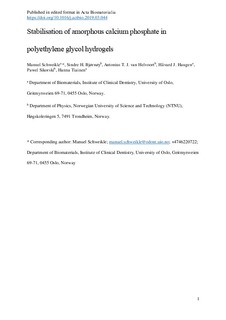| dc.contributor.author | Schweikle, Manuel | |
| dc.contributor.author | Bjørnøy, Sindre Hove | |
| dc.contributor.author | Van Helvoort, Antonius | |
| dc.contributor.author | Haugen, Håvard Jostein | |
| dc.contributor.author | Sikorski, Pawel | |
| dc.contributor.author | Tiainen, Hanna | |
| dc.date.accessioned | 2020-01-30T08:01:14Z | |
| dc.date.available | 2020-01-30T08:01:14Z | |
| dc.date.created | 2019-03-26T15:17:49Z | |
| dc.date.issued | 2019 | |
| dc.identifier.citation | Acta Biomaterialia. 2019, 90 132-145. | nb_NO |
| dc.identifier.issn | 1742-7061 | |
| dc.identifier.uri | http://hdl.handle.net/11250/2638734 | |
| dc.description.abstract | Acellular polymer-calcium phosphate composites are promising bone graft materials. Hydrogels are suitable for providing a temporary matrix, while calcium phosphate minerals serve as ion depots for calcium and phosphate required for de novo bone formation. Crystalline calcium phosphates are stable under biological conditions and are commonly used in such scaffolds. However, the low solubility of these phases reduces the availability of free ions and potentially obstructs the remodelling necessary for the formation of mineralised tissue. Here, we investigate two different strategies to stabilise amorphous calcium phosphates in a synthetic polyethylene glycol-based hydrogel matrix. In vitro experiments mimicking an injectable application showed that amorphous calcium phosphate (ACP) of variable stability was formed in the hydrogel matrices. In additive-free composites, ACP transformed into brushite within minutes. Citrate or zinc additives were found to stabilise the formed ACP phase to different degrees. In the presence of citrate, ACP was stable for at least 2 h before it transformed into hydroxyapatite within 3–20 days. Partial calcium substitution with zinc (Zn/Ca = 10%) produced zinc-doped ACP of high stability that did not show signs of crystallisation for at least 20 days. The presented methods and findings open new possibilities for the design of novel injectable synthetic bone graft materials. The possibility to produce ACP with tailorable stability promises great potential for creating temporary scaffolds with good osteogenic properties. Statement of significance Synthetic hydrogel-calcium phosphate (CaP) composites are promising biomaterials to replace human- and animal-derived bone scaffolds. Most reported hydrogel-CaP composite materials employ crystalline CaP phases that lack the osteoinductive properties of autograft. Stabilising amorphous calcium phosphates (ACP) could overcome this limitation, readily delivering calcium and phosphate ions and facilitating remodelling into new bone tissue. The design of synthetic hydrogel-ACP scaffolds, however, requires more understanding of the mineralisation processes in such matrices. This study presents a model system to characterise the complex mineral formation and transformation processes within a hydrogel matrix. We demonstrate a facile route to produce self-mineralising injectable synthetic hydrogels and prove two different strategies to stabilise ACP for different periods within the formed composites. | nb_NO |
| dc.language.iso | eng | nb_NO |
| dc.publisher | Elsevier | nb_NO |
| dc.relation.uri | https://www.sciencedirect.com/science/article/pii/S1742706119302193 | |
| dc.rights | Attribution-NonCommercial-NoDerivatives 4.0 Internasjonal | * |
| dc.rights.uri | http://creativecommons.org/licenses/by-nc-nd/4.0/deed.no | * |
| dc.title | Stabilisation of amorphous calcium phosphate in polyethylene glycol hydrogels | nb_NO |
| dc.type | Journal article | nb_NO |
| dc.type | Peer reviewed | nb_NO |
| dc.description.version | acceptedVersion | nb_NO |
| dc.source.pagenumber | 132-145 | nb_NO |
| dc.source.volume | 90 | nb_NO |
| dc.source.journal | Acta Biomaterialia | nb_NO |
| dc.identifier.doi | 10.1016/j.actbio.2019.03.044 | |
| dc.identifier.cristin | 1687918 | |
| dc.relation.project | Norges forskningsråd: 231530 | nb_NO |
| dc.relation.project | NORTEM: 197405 | nb_NO |
| dc.description.localcode | © 2019. This is the authors’ accepted and refereed manuscript to the article. Locked until 21.3.2021 due to copyright restrictions. This manuscript version is made available under the CC-BY-NC-ND 4.0 license http://creativecommons.org/licenses/by-nc-nd/4.0/ | nb_NO |
| cristin.unitcode | 194,66,20,0 | |
| cristin.unitname | Institutt for fysikk | |
| cristin.ispublished | true | |
| cristin.fulltext | postprint | |
| cristin.qualitycode | 1 | |

